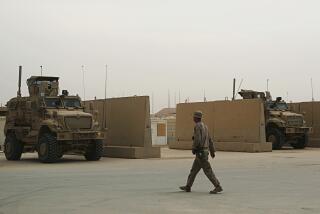Obama orders rapid drawdown of U.S. troops from Afghanistan
Reporting from Washington — Declaring that the “tide of war is receding,” President Obama ordered a rapid withdrawal of the 33,000 “surge” troops he sent to Afghanistan and charted a path toward ending large-scale U.S. combat operations in Central Asia.
In a nationally televised address Wednesday evening, Obama took care to emphasize what he sees as the successes of the last two years in Afghanistan, saying he was beginning to draw down the number of U.S. troops “from a position of strength” after an intensive counterinsurgency effort.
“We have put Al Qaeda on a path to defeat,” he said, prominently citing the killing of the terrorist network’s leader, Osama bin Laden.
And while he briefly acknowledged the reality that U.S. troops would be fighting in Afghanistan for at least another three years and that “huge challenges remain,” Obama’s emphasis was on a door closing on a decade of war.
“It is time to focus on nation-building here at home,” the president said. “These long wars will come to a responsible end.”
Obama also sought to draw a larger lesson from the last 10 years of U.S. warfare in the Middle East and Central Asia, saying the country needs to “chart a more centered course” between “an isolation that ignores the very real threats that we face” and the urge to “overextend ourselves, confronting every evil that can be found abroad.”
America should be pragmatic regarding future decisions to deploy military troops, he said. “When threatened, we must respond with force. But when that force can be targeted, we need not deploy large armies overseas.”
The president cited the NATO operation in Libya as an example of how the U.S. can use international coalitions to achieve its objectives without putting troops on the ground.
The drawdown plan reflects the political realities of a nation that has tired of war. Obama’s Republican opponents in recent days have mostly called for less, not more, U.S. engagement overseas.
The timetable calls for withdrawing 10,000 troops this year and having all of the surge forces — ordered to Afghanistan by the Obama administration in late 2009 — out by the end of next summer, just as the election season reaches its peak.
The speed of the drawdown also shows the influence of advisors, including Vice President Joe Biden, who have argued that Pakistan, not Afghanistan, is now the center of the Al Qaeda threat and that a large military force in Afghanistan is unnecessary.
“The threat has come from Pakistan over the past half-dozen years or so and longer,” one senior administration official said, speaking on condition of anonymity. “What we’ve been able to do … is to degrade Al Qaeda’s core capabilities significantly.”
White House officials said there was no sign the Afghan Taliban or other groups were using Afghanistan as a launching pad to carry out attacks against the U.S. or other countries.
But the withdrawal is faster than Obama’s military commanders wanted. Army Gen. David H. Petraeus, the outgoing commander in Afghanistan, preferred options that would have kept most of the surge forces in Afghanistan longer, until the end of 2012 at least, military officials said. Getting the surge troops out by September 2012 will mean many will begin leaving during next summer’s fighting season, military officials said.
The drawdown will leave the military with about 68,000 troops in Afghanistan in the fall of 2012. Commanders worry a force that size will be unable to achieve their objectives in both eastern and southern Afghanistan.
Petraeus, who has been nominated to head the CIA, will turn the Afghan command over to Marine Lt. Gen. John R. Allen as early as next month. Allen will face a difficult decision about whether to shift U.S. military units into the east, where the insurgency remains potent, or leave the bulk of his forces in the south to consolidate the security gains achieved in the last year.
Pentagon officials hope that by keeping the military pressure on through next summer they can further weaken the Taliban, possibly even persuading parts of the insurgency to enter peace negotiations. The administration is pinning considerable hopes on such talks.
“Peace cannot come to a land that has known so much war without a political settlement,” Obama said.
But military officials worry that an expedited departure will encourage Taliban leaders to simply bide their time before renewing their push for power. Some military leaders are also dubious about the prospects of drawing the disparate ranks of insurgents into serious peace talks.
Stephen Biddle, a military strategy expert with the Council on Foreign Relations, said Obama’s efforts to reassure his domestic audience that the U.S. was shrinking its presence were at odds with the need to convince the Taliban that it should abandon the insurgency and enter into a peace deal.
The drawdown announcement was meant to signal to the American public and lawmakers that “we’re cutting our expenses and reducing our commitment in Afghanistan,” Biddle said. But that “is not the message you would ideally like the Taliban to hear” because it might encourage them not to come to the negotiating table, he added.
Pentagon officials said that, in ordering the pullout, Obama was leaving it up to military commanders to decide on the timing and what types of units will be taken out. A senior officer said some U.S. troops would begin coming out in July, as Obama promised, but that the initial withdrawals would be small and might not include combat units.
“The only requirement is that 10,000 troops come out by the end of December,” and it would be up to commanders to decide on the pacing, the officer said.
Defense Secretary Robert M. Gates, who is retiring at the end of the month, said in a statement Wednesday that he supported Obama’s decision “because it provides our commanders with enough resources, time and, perhaps most importantly, flexibility to bring the surge to a successful conclusion.”
More to Read
Sign up for Essential California
The most important California stories and recommendations in your inbox every morning.
You may occasionally receive promotional content from the Los Angeles Times.












